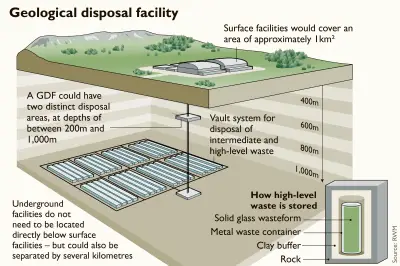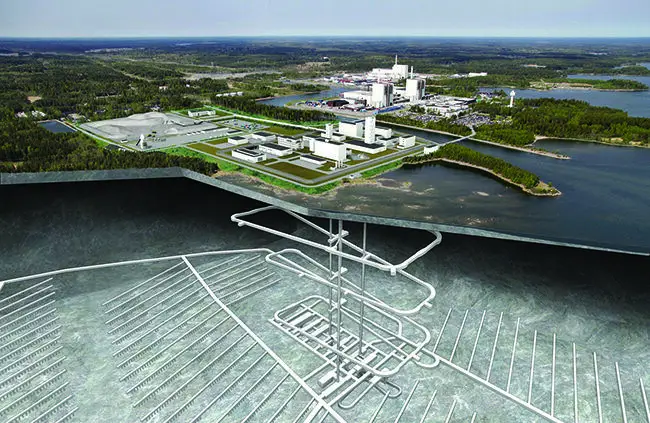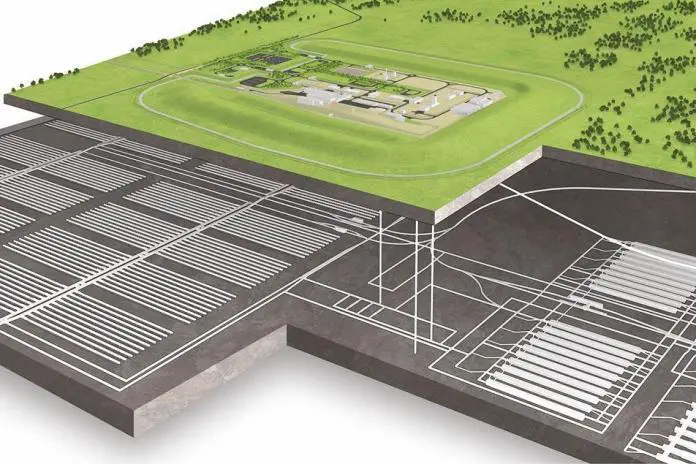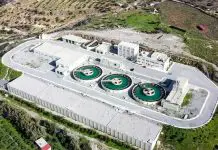Geological disposal has been deemed the safest permanent solution for disposing of nuclear wastes. This method entails burying the waste several hundred metres beneath solid rocks at a Geological Disposal Facility (GDF). In numerous countries, including Canada, Finland, France, Sweden, and Switzerland, this strategy has already been adopted. Some of these nations such as Sweden and Finland have made significant progress in creating their own GDFs.
The use of geological disposal is made possible by cutting-edge engineering, science, and technology. This entails isolating the radioactive waste in tunnels and vaults that are 200 to 1000 metres below the surface and are completely sealed. The radiation is safely contained in the vaults as it degrades naturally over time, and it is never allowed to rise to the surface in dangerously high concentrations.

Solid radioactive waste is packed in safe, engineered containers, usually made of metal or concrete, and buried hundreds of metres below the surface in a stable rock formation with the containers encased in clay or cement. The term is referred to as the “multi-barrier method”.
Recently, the All-Party Parliamentary Group on Infrastructure (APPGI) in the UK has received an industry update on GDF from Karen Wheeler, CBE, the Deputy CEO and Major Capital Programmes Director in the UK. Karen disclosed the information to the Institution of Civil Engineers (ICE) UK. The APPGI is Parliament’s leading cross-party group dedicated to economic infrastructure in the UK. According to Karen, she was thrilled to inform the APPGI about the crucial infrastructure program that her organization is in charge of this month.
Environmental Sanitization
On the environmental clean-up, she explained, “For more than 60 years, nuclear technology has been a part of our daily life. It has been used to power houses and companies, identify and cure severe ailments, and defend our nation. Nevertheless, this technique has produced radioactive waste that must be handled carefully over an extended period. Although current above-ground storage is secure, it is not a long-term solution.”
The UK government has tasked Nuclear Waste Services (NWS), a division of the Nuclear Decommissioning Authority (NDA), with finding a long-term solution for higher activity radioactive waste in order to safeguard the environment and future generations. The use of Geological Disposal has been universally accepted as the long-term and sustainable solution to nuclear waste containment.
Geological disposal requires no ongoing maintenance, and it is less vulnerable than surface storage to human activities such as terrorism or war. Furthermore, it is less vulnerable than surface storage to natural processes such as climate change. With this approach, the waste will finally be permanently sealed to assure safety without the need for additional action after being deposited into a GDF, far below earth and away from humans and the environment.

Sample Design of a Geological Disposal Facility
Kareen further discussed on locating a cooperative community and suitable location. She notes that it is necessary because the policy is consent-based and so it is important to select both a suitable site and a community that is open to it. Only having one or the other will not be sufficient.
In England or Wales, the ‘Working with Communities Policy’ outlines the procedure for interacting with potential host communities, including local decision-making to demonstrate willingness (or disinterest) to host a facility.
According to Karen, she and her team are working hard to address concerns about regional consequences, safety, security, transportation, and other challenges, both nationally and locally.
Furthermore, she added that involving locals in selecting what they want for their communities is most important. According to her, “This project is genuinely transformative. Large project of this nature, which will generate local investment, infrastructure, skills, and thousands of employment over the course of more than a century, can be advantageous to communities in the long run.”

Geological Disposal Facilities: Facts and Figures
- A GDF will be erected 200 to 1,000 meters below ground.
- For surface amenities, it will be about 1 km2 large, or 800 Olympic-sized swimming pools.
- Over 20 km2 will be devoted to subsurface dumping zones.
- The GDF might build a network of disposal locations and tunnels 300–400 kilometers underground.
- Additionally, it could have accessways and drifts that extend for miles.
- The GDF will run for more than a century and generate a large number of employment.
Independent Regulation
As a conclusion, Karen said “We collaborate closely with independent regulators. The suggested site, the designs for a GDF, and the underlying science will be examined by the Office for Nuclear Regulation and the Environment Agency to ensure safety. Then the GDF can be constructed.”










